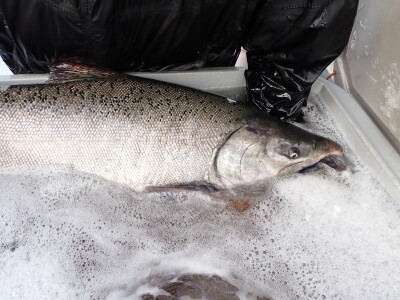Northeast
Lobster boat takes passengers; rebuilding is affordable option
The day after Christmas, SW Boatworks in Lamoine, Maine, launched a 40-footer in nearby Northeast Harbor. The Lucky Catch was an RP Boat Shop hull that SW Boatworks finished off for Tom Martin who runs Lucky Catch Cruises in Portland.
Martin will lobster from the Lucky Catch as well as take paying passengers out to see how lobstering is done.
Since the Lucky Catch is licensed to carry 49 passengers, several Coast Guard requirements had to be met that a boatbuilder doesn't normally deal with when constructing a lobster boat used only for commercial fishing. That includes installing a fixed firefighting system — in this case from Fireboy — and a remote shutoff for the engine-room ventilation. That's to cut off air from an engine-room fire and to keep the engine from sucking in the Fireboy's discharge.
All-aluminum fuel tanks are needed, and all the wiring and hoses have to be Coast Guard approved and held in place with metal clamps, not plastic. A watertight bulkhead was also required, which is the main bulkhead. Plus the building plans had to be submitted for Coast Guard approval.
Along the wash decks and across the stern are built-in sockets for removable handrails to replace the trap rack and tailgate when Martin is carrying passengers.
Another feature of the boat to accommodate its dual role of carrying both lobsters and paying passengers is an easily removable winter back for the wheelhouse.
"It's a pain to have to unbolt everything. The winter back is made in pieces and comes right out. The top is all self-supporting," says Stewart Workman, SW Boatworks' owner.
Down below is a head, V-berth and equipment locker. The working deck is 3/4-inch plywood covered with three layers of fiberglass and supported by 2 x 4 pressure-treated deck beams. It has built-in lobster tanks and a storage space.
Prior to completing the Lucky Catch, SW Boatworks finished off a 38-foot Calvin Beal design for Bruce Young of Bar Harbor, Maine. The Catman was the second boat SW Boatworks has completed for Young, Workman says. With an 850-hp Caterpillar C15, Catman hit 31 knots.
Currently, SW Boatworks is finishing off a 36-foot Wayne Beal hull for a New Hampshire owner who will use it as a pleasure boat. It started out as a spec boat and was about one-third completed when Frank DiTommaso bought it. The boat has a 500-hp Caterpillar C9 for power.
In Walpole, Maine, Farrin's Boatshop sold the 36-foot Wayne Beal hull it had started to finish off as a spec boat to a New York commercial fisherman. It will probably have a Caterpillar engine.
The crew at the boatshop is finishing off a 36-foot Mitchell Cove hull for a California boat owner who will use it as a pleasure boat. This was the first Mitchell Cove hull laid up by Journey's End Marina in Rockland, Maine, after they bought the Mitchell Cove molds.
In March, Farrin's Boatshop is starting a project that might be on the minds of a number of fishermen: rebuilding their old fiberglass lobster boat, instead of buying a new one, now that they are facing rising fuel and bait prices along with the pending cost of whale conservation gear measures.
Peter Poland of Round Pound, Maine, will be dropping off his 40-footer that was built in 1998, and six to eight weeks later will pick up a boat that looks like new, says the boatshop's Bruce Farrin. The Alexandria was the first hull to come out of Wayne Beal's Boat Shop in Jonesport, and Farrin's Boatshop finished it off, 10 years ago.
The 650-hp Mack engine will be hauled out and sent to New Hampshire to be rebuilt. While that's going on, Farrin says, "We'll check everything out — the hoses, fittings, all the hydraulics — and anything that shows wear and tear will be replaced."
Farrin figures the prop will be reconditioned, and the shaft slid back to see if it's worn and needs to be pulled. Once everything is done, the boat will be re-gelcoated.
Two years ago, the boatshop did the same job on a 40-foot Young Brothers boat, only the engine wasn't rebuilt.
"Doing this kind of work, a fisherman spends one-third the cost of a new boat and can go full-speed ahead for five or six years," Farrin says. — Michael Crowley
West
New boat, not retirement, at 74; widened hull won't slow dragger
In 2007, after eight years without building a hull for a commercial fisherman, Wegley Boats in Bellingham, Wash., built the Elena Marie, a fiberglass 40-foot gillnetter for Alaska salmon fisherman Mark Saldi (see "Just what he always wanted," NF Oct. 07, p. 32). In early January 2008, Wegley Boats was finishing up another hull for a commercial fisherman, only this one will be a 32-foot Bristol Bay gillnetter. Like the Elena Marie, it is going to Edling Enterprises, also in Bellingham, to be finished off.
The 32-footer is being built for Svien Nyhammer who has been gillnetting in Bristol Bay since 1966, says John Edling, owner of Edling Enterprises. The 74-year-old Nyhammer is also owner of the Rollo, the Bering Sea crabber of "Deadliest Catch" notoriety. His son, Eric, runs the boat.
"Svien is 74 and building a new boat. I told him I was proud of him," says Edling, who, besides building and repairing boats, has also been a Bristol Bay gillnetter for 29 years. Most recently Edling has been fishing from a Master Marine hull he finished off five years ago and calls the Roadster.
Except that Nyhammer's boat will be 8 feet shorter, it will resemble the Elena Marie with an extended and raised house and flush deck.
A 375-hp John Deere will go down on the engine beds, and there will be a refrigerated seawater system from Integrated Marine Systems in Port Townsend, Wash. The fish hold has a capacity of about 15,000 pounds.
Edling Enterprises is also repowering a 32-foot Bristol Bay gillnetter built in 1978. The boat's original engine, a Volvo Penta 70B is being removed and a rebuilt 350-hp Volvo Penta 70B is going in the boat. "You can't get parts for the 70B anymore," Edling says.
The crew at Edling Enterprises is also putting on a new flush deck. "A lot of the older Bristol Bay boats with cockpits are going with flush decks," Edling says. "It gives you more room for refrigeration, a little more hatch and instead of pitching every fish on deck, they can be slid into the hatch."
Integrated Marine Systems is also supplying an RSW system for the boat. Whereas Nyhammer's is hydraulically powered off the main engine, this RSW system has its own 3-cylinder Isuzu.
"You can shut the main engine down and run this like an auxiliary," Edling says.
Both the boat that's being repowered and Nyhammer's boat have to be done in time to be loaded on a barge and shipped to Bristol Bay for the June opening.
In Everett, Wash., the Icy Mist came into Hansen Boat Co. at 58' x 22' in mid-September and left just before the first of the year at 58' x 28' 6'', after a sponsoning job. The combination pot boat and dragger also picked up a bulbous bow and a new generator.
"The boat was sponsoned both to improve her stability and fish-hold capacity," says the boatyard's Rick Hansen. The extra hold capacity was gained in the main fish hold.
Prior to the sponsoning, void areas and water tanks took up the area between the hold and side plating. These were moved into the sponsons and the hold was pushed out to the original plating, giving about 3 feet more area on each side of the hold.
With the hull being widened, the pilothouse was moved out by one window or approximately 30 inches, Hansen says. The hauling stations also had to be moved out. That and a new knuckle deck crane required a new valve bank and a rearrangement of the hydraulics on the back of the house.
"As long as we were doing that, we ran as much stainless hydraulic lines as we could and rehosed everything from there," Hansen notes.
When you start moving one thing, that means more things usually follow. So in addition to the trawl winches and gantries being placed farther o
utboard, the hydraulically lifted bleeding and sorting table followed the hauling station outboard.
Down below, a new Caterpillar 3306 generator replaced a Cat 3304. "The 3306 bumped the kilowatts up from 50 to 60. Now two refrigeration systems can be run at one time if there's a need to pull down a large load in a hurry," Hansen says.
The bulb was added to counteract the flotation being created in the stern and to keep the Icy Mist from losing speed, because of the now wider hull. — Michael Crowley
South
Father and son repair crabber; deep water benefits boatyard
James Akers of Water View, Va., is a highline crabber on the Rappahannock River and Chesapeake Bay. During the spring and summer crab season, he and his son, Thomas, fish 600 peeler pots and 400 crab pots, hauling 500 pots a day from the elder Akers' classic wooden boat, the Miss Gail.
James Akers pulled the 38' x 12' Miss Gail out of the water in December for repairs. Helping Akers out with plenty of welcome advice was John D. England, who also supplied the lumber Akers needed.
England is a longtime builder of wooden boats and boat lumber dealer in Urbanna. He is currently project manager for the restoration of the crab dredger F.D. Crockett, which was built in 1924. The F.D. Crockett is a 60-foot log-deck boat owned by the Deltaville Maritime Museum. (Deck boat is a generic term for a decked-over Chesapeake Bay boat with a mast and boom forward of the house. This one was built of shaped logs instead of sawn planking.) England is overseeing the complete restoration of the historic boat.
The Miss Gail needed a portion of its stern deck and gunwales replaced, as well as new washboards, toe rails and guards. The father and son team did the work, with England advising them.
"I carefully watched how it came out, and we put it back the same way," he says. "You figure, if it's been on the boat since it was built in 1965, the builder knew what he was doing."
Alfred J. Norris, a backyard builder of wooden boats, constructed the Miss Gail in Deltaville. The boat has never been out of the family, as Akers' father-in-law, James Verlander, had the Miss Gail built. He fished oysters in the Rappahannock River.
For the stern deck and washboards, 1 1/4-inch-thick juniper was used. The toe rails, guards and gunwales were shaped from pressure-treated pine. "I purchased the juniper from John England and he helped me a lot on it. I had several questions, and he came down here and explained how I needed to do it. He's a very nice man and very helpful," Akers says.
Once all the topside woodwork was completed, the crab boat was coated with a flat, white enamel paint and the bottom got a coating of antifouling paint.
A 210-hp Cummins diesel powers the Miss Gail. It's hooked up to a BorgWarner marine gear with a 1.5:1 reduction. "We work her hard but we take good care of her," says Akers, referring to the engine.
At the Chesapeake Marine Railway in Deltaville, the Miz Juanita B, an 84' x 34' x 12' wooden scalloper, was on the rails.
St. Augustine Trawlers, of St. Augustine Fla., built the boat in 1984, just five years before the boatyard stopped building new wooden commercial fishing boats.
Benavidez and Sons of Seaford, Va., bought the Miz Juanita B six years ago. Chesapeake Marine Railway is installing a new stainless steel rudder tube, repairing the steel wear plates on the stern, putting on a new 60-inch, four-blade prop, as well as replacing planking and painting the topsides and bottom.
The scalloper has a 620-hp at 1,800-rpm Caterpillar 3412 for power.
Chesapeake Marine Railway is located on Fishing Bay and has deep enough water at either high or low tide to haul and launch the 84-footer. This is what attracted the boat's owner to the yard, says Andy Benavidez, one of the sons in the company's name.
"We need the boat soon," Benavidez says. "We have got some trips in the area of the Elephant Trunk, and that's good fishing in there. We need to get that trip in before March."
This is the first time Benavidez says they have brought a boat to Chesapeake Marine Railway. Normally they would use a boatyard closer to the company's home, but they needed a haul-out facility that could launch at any time.
"We would rather use yards closer to home, but we are in a rush. The yards close to us can only haul and launch at high tide, and if you get a southwest wind in some of those creeks, the water stays out even at high tide."
Benavidez recently had a boat on the rails four weeks longer than anticipated because of low water. — Larry Chowning






